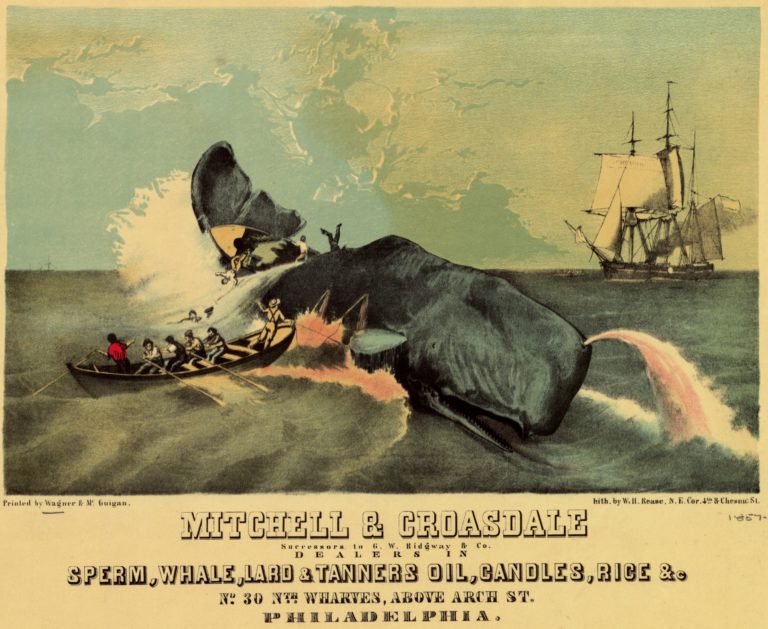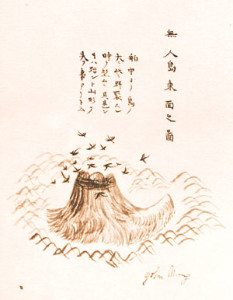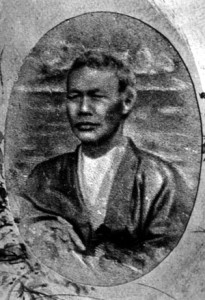Herman Melville and John Manjiro

Did war ships or whaling ships “open” Japan in the middle of the nineteenth century? The complementary fates of two sea drifters, the American Herman Melville and the Japanese John Manjiro, help answer the question. Melville and Manjiro, who crisscrossed the Pacific during the 1840s, offer a particularly mesmerizing example of suggestive coincidence. The oddly parallel lives of these two “Pacific men” (to borrow a term from the poet Charles Olson’s Call Me Ishmael) help us to understand both the nature of the multicultural floating world of the Pacific during the mid-nineteenth century and the emerging relationship, crucial to both countries, between the United States and Japan. The twin tale of Melville and Manjiro complicates the usual narrative of Commodore Matthew Perry’s fabled opening of Japan 150 years ago, when his so-called Black Ships steamed into Edo Bay and demanded, in the name of President Millard Fillmore, that Japan open its ports to the West.
On January 3, 1841, the twenty-one-year-old Herman Melville boarded the whaling ship Acushnet in Fairhaven, Massachusetts, bound for the rich whaling grounds off the coast of Japan. Two days later, on January 5, the boy Manjiro, a fourteen-year-old fisherman from a small village, boarded a fishing vessel on the coast of Shikoku, the smallest of the four main islands of Japan. Melville’s itinerary, at least for the next few months, progressed more or less according to plan, rounding Cape Horn and entering the Pacific. Manjiro’s did not. His small boat was caught in a storm and drifted far out to sea, where it was eventually wrecked on the tiny island of Torishima, or Bird Island. Months later, Manjiro and his four companions were rescued by the whaling ship John Howland, like Melville’s boat out of Fairhaven, Massachusetts, under the command of Captain William Whitfield. Whitfield took the castaways to the Sandwich Islands (later renamed Hawaii) and entrusted them to his friend, the medical missionary Dr. Gerrit P. Judd. Judd ascertained that they were Japanese, and found employment for them as servants with local American families. Captain Whitfield, childless and deeply impressed with Manjiro’s acumen and spirit, asked to adopt him and take him home to Fairhaven, an arrangement agreed to by all.
Meanwhile Melville, bored with the monotony of whaling, abandoned ship in the Marquesas (an experience detailed in his partly fictionalized novel Typee), and made his way to Honolulu. There he found himself in the midst of a conflict between, on the one hand, British naval officers and, on the other, the local King Kamehameha III and his American prime minister, the very same Dr. Judd, whom Melville called “a sanctimonious apothecary-adventurer.” A clerk for a British merchant, Melville sided with the British, and wrote angrily in Typee about Judd’s predatory operations in Hawaii.
Melville was moved by the native cultures of the South Seas and appalled by what the missionaries had wrought in Hawaii. “Not until I visited Honolulu,” he wrote sardonically, “was I aware of the fact that the small remnant of the natives had been civilized into draught horses, and evangelized into beasts of burden.” He suggested that the missionary trade was going in the wrong direction: “Four or five Marquesan Islanders sent to the United States as Missionaries might be quite as useful as an equal number of Americans dispatched to the Islands in a similar capacity.” If the missionary plague spread across the South Pacific, there was always, in Melville’s view, inaccessible Japan, which had wisely expelled her Christian missionaries during the early seventeenth century and locked the doors behind them. “So, hurrah for the coast of Japan! Thither the ship was bound,” Melville wrote wishfully at the end of Omoo, his lively sequel to Typee.
Herman Melville never reached the shores of Japan, however, returning instead to New York and western Massachusetts to write his books. He knew that Japan was a country, like death, from which no traveler returned. Except for a narrow trickle of goods and ideas filtered through Dutch traders at Nagasaki, Japan was officially closed to the West for 250 years, with xenophobia as national policy. Travel abroad was punishable by death; visitors from abroad, such as shipwrecked whaling crews, were routinely tortured, forced to trample Christian icons, and killed.
If Melville never traveled to Japan, he was fascinated by the island nation nonetheless, as a kind of heart of darkness of the Pacific. “The same waves wash . . . the new built Californian towns, but yesterday planted by the recentest race of men, and lave the faded but still gorgeous skirts of Asiatic lands, older than Abraham,” he wrote, “while all between float milky-ways of coral isles, and low-lying, endless, unknown Archipelagoes, and impenetrable Japans.” Like Conrad’s Kurtz on the Congo, Melville discerned in Japan a realm of mystery and ultimate horror. In Moby-Dick (1851), he fitted out his imaginary whaling ship the Pequod with masts cut from trees along the coast of Japan and a captain, the monomaniacal Ahab, who had been “dismasted”—deprived of a leg—off the coast of Japan. The path of the Pequod with its polyglot crew is a direct route to the Japan whaling grounds, the lair of Moby-Dick. The triple threat of a typhoon, a crazed captain, and a white whale spell disaster for Ahab’s ship.
But Melville also thought that the two nations that faced each other across the Pacific were somehow meant for each other’s embrace. He sensed that the United States would play its part in prying open a recalcitrant Japan, and predicted as much in Moby-Dick: “If that double-bolted land, Japan, is ever to become hospitable, it is the whale-ship alone to whom the credit will be due; for already she is on the threshold.”
Oddly enough, Melville’s prediction was about to come true, though not quite in the direct way that he had imagined. For just as Melville was wondering what it might take to open Japan, Manjiro was embarked on his own extraordinary journey to open the United States. Manjiro, renamed “John Mung” by the sailors on board the John Howland, arrived in Fairhaven (facing New Bedford across the Acushnet River) in May of 1843, when he was sixteen. Of the ten years he spent away from his native Japan, as Junji Kitadai points out in his translation of Manjiro’s travels, Drifting toward the Southeast, Manjiro was on land for only four of them—as much aboard as abroad.
In 1846, having gone to school in Fairhaven and learned both celestial navigation and the barrel maker’s trade in New Bedford, Manjiro joined the crew of the whaling bark Franklin, an ill-fated voyage in which the crew seized control from the mad captain (an incident that may well have inspired the scene in Moby-Dick when Ahab, off the coast of Japan, threatens Starbuck with a musket), and appointed Manjiro second mate. In 1849, Manjiro made the seven-month journey around Cape Horn to join the forty-niners in California. There, pan-handling alone, he amassed enough gold to fund a voyage back to Honolulu, where he was reunited with his fellow castaways. In Hawaii he made arrangements for a dangerous return journey to Japan and landed in the Rikyu Islands in the winter of 1851.
Manjiro’s return to Japan is remarkable for many reasons. He helped to persuade the Japanese authorities that neither he nor the United States was a threat to Japan. His timing was impeccable. At the very moment that Melville, in 1851, was predicting that whaling ships would open Japan, Manjiro was arriving on Japanese shores in a whaling boat. And just as Manjiro was enduring lengthy interrogations—during which he made the case for the benefits of American technology and American-style government— Commodore Perry was preparing his armada of Black Ships for the voyage to Japan.
Manjiro was reunited with his mother in Tosa Province (now Kochi Prefecture) in Shikoku, and almost immediately summoned by the forward-looking provincial lord to educate young samurai leaders in the ways of the West. Promoted to the rank of samurai himself, Manjiro had barely begun his work in Kochi when Perry’s flotilla arrived in Edo Bay, in the summer of 1853, a complete surprise to the Japanese. As Kitadai points out, the United States in 1853 was “an unknown entity” to the Japanese. “No one in Japan had a working knowledge of the English language”—no one, that is, except Manjiro, who at the age of twenty-six was accordingly summoned to Tokyo for meetings with Masahiro Abe, the shrewd prime minister, and other Tokugawa officials.
Perry, who had presented his demands for access to Japanese ports and safe treatment of American sailors, promised to return the following year for an answer. The Tokugawa regime was desperate for information on the Americans, and again Manjiro painstakingly sought to educate Abe and the others concerning the geography, history, culture, and government of the United States. He described the wonders of steam engines and railroads and elected presidents. He tried to persuade the Japanese officials that they had much to learn from the Americans, and that Japan was hurting herself by her policy of self-imposed isolation.
Unfortunately, not all the officials trusted Manjiro. While Abe wished to employ him as interpreter for all future dealings with Perry, another official suspected that Manjiro might be a spy—a sort of American Trojan Horse dropped off the coast of Japan. But Manjiro’s assurances about the essential benevolence of the Americans carried the day with the Japanese officials who may have felt, nonetheless, that faced with American will and weaponry they had little choice.
When Commodore Perry returned to the United States, he expected a hero’s welcome, but Washington had other things to think about, including the threat of civil war. Commodore Perry decided he needed better PR, and asked Nathaniel Hawthorne if he would consider writing a book about the opening of Japan, with Perry as hero. Hawthorne was tempted. As he wrote in his journal on December 28, 1854, “It would be a very desirable labor for a young literary man, or for that matter, an old one; for the world can scarcely have in reserve a less hackneyed theme than Japan.” But Hawthorne had other books on his mind, and suggested that Perry ask Herman Melville, who knew something about the Pacific, to write the book. Perry, stupidly, decided to write the book himself. Herman Melville’s book on the opening of Japan remains one of the great might-have-beens in American literature.
Manjiro, for his part, continued to work toward an opened Japan, serving as an interpreter of American things to the Japanese. He was the official curator of gifts—including a telegraph machine, a daguerreotype camera, and a quarter-scale steam-powered railroad train on a circular track—from Perry’s expedition, since he alone knew what such marvels were for. Manjiro also became a curator of language, writing the first Japanese guide to spoken English and spending several years translating Nathaniel Bowditch’s Practical Navigator—the “seamen’s bible”—which allowed ships at sea to find their bearings from the moon and stars. Manjiro became, in sum, what the anthropologist James Clifford calls a “Squanto figure,” someone who lives between cultures. Melville, too, was a Squanto figure of sorts, a trafficker in languages and cultures. His Typee is an eloquent plea for tolerance of “primitive” cultures, and Moby-Dick offers a vision of men of different nationalities working in concert on a whaling ship.
Manjiro and Melville were most at home at sea. They were Pacific men, as their friends and associates recognized. When a thirty-three-year-old Manjiro helped navigate the first Japanese clipper ship across the Pacific to San Francisco in 1860, an American naval officer on board admired his calm during a typhoon: “Old Manjiro was up nearly all night. He enjoys the life, it reminds him of old times.” Hawthorne wrote of his friend Melville, who also nostalgically reentered the Pacific in 1860 and stopped in San Francisco: “I do not know a more independent personage. He learned his traveling habits by drifting about, all over the South Sea, with no other clothes or equipage than a red flannel shirt and a pair of duck trousers.” As Melville himself had written in his great Pacific chapter (111) of Moby-Dick: “To any meditative Magian rover, this serene Pacific, once beheld, must ever after be the sea of his adoption.”
Herman Melville called pre-Perry Japan “that double-bolted land,” and Japan, in fact, had to be unlocked not once but twice. Perry did the easy part, forcing Japan to open her major ports to Western ships and Western trade. But there was a second, more significant opening of Japan; this second opening happened much more slowly. It was one thing to fire a few cannonballs across Edo Bay and run a miniature railroad along the beach to impress the samurai. It was quite another to grasp the subtle moves of judo, the tenets of Esoteric Buddhism, or to understand why the most highly prized vessel in the tea ceremony was a dun-colored water jar that had collapsed in the kiln. In this second sense, the opening of Japan occurred as much in the hearts and minds of individuals as in some particular location in Japan or the United States. What sets such people as Melville and Manjiro apart, I think, is that at a certain point it no longer makes sense to speak of them only as travelers or interpreters or guides or Squanto figures. Over time, their cultural encounters occurred not so much between worlds as within themselves.
This idea gives me a way to understand why I am uncomfortable when people speak about the Japanese influence in America or the American imprint in Japan. That model implies a simplistic diorama of Perry and the natives: here are the Japanese with their interesting art objects, and there are the Americans trading modern technology with them. Think of this as the particle theory of cultural exchange. But what we see in nineteenth-century America and Japan is something more complicated and harder to name. Perhaps we need a wave theory of cultural exchange, too. In Pacific men like Melville and Manjiro there is a constant oscillation, a great wave, between East and West. “I believe good will come out of this changing world,” Manjiro wrote to his benefactor, Captain Whitfield, in 1850. In opening themselves to this changing world, Manjiro and Melville opened themselves as well.
Further Reading:
Manjiro’s story is vividly recounted in his own words in Drifting Toward the Southeast, translated by Junya Nagakuni and Junji Kitadai (New Bedford, 2003). Katherine Plummer provides a usefulcontext for such sea drifters in The Shogun’s Reluctant Ambassadors (Tokyo, 1984). And Donald Bernard’s The Life and Times of John Manjiro (New York, 1992) is a well-informed biography. Melville’s Moby-Dick is available in many editions. For a more sustained comparative analysis of Melville and Manjiro, see the first chapter, “The Floating World,” of Christopher Benfey’s The Great Wave: Gilded Age Misfits, Japanese Eccentrics, and the Opening of Old Japan (New York, 2003). An exhibition featuring Manjiro entitled “Pacific Encounters: Yankee Whalers, Manjiro, and the Opening of Japan,” is on view at the New Bedford Whaling Museum through April 2005.
This article originally appeared in issue 5.2 (January, 2005).
Christopher Benfey is Mellon Professor of English at Mount Holyoke College and the author of books on Emily Dickinson and Stephen Crane, as well as The Great Wave: Gilded Age Misfits, Japanese Eccentrics, and the Opening of Old Japan (New York, 2003). Benfey writes for many publications, including the New York Review of Books and The New Republic.



